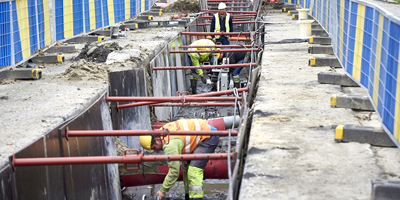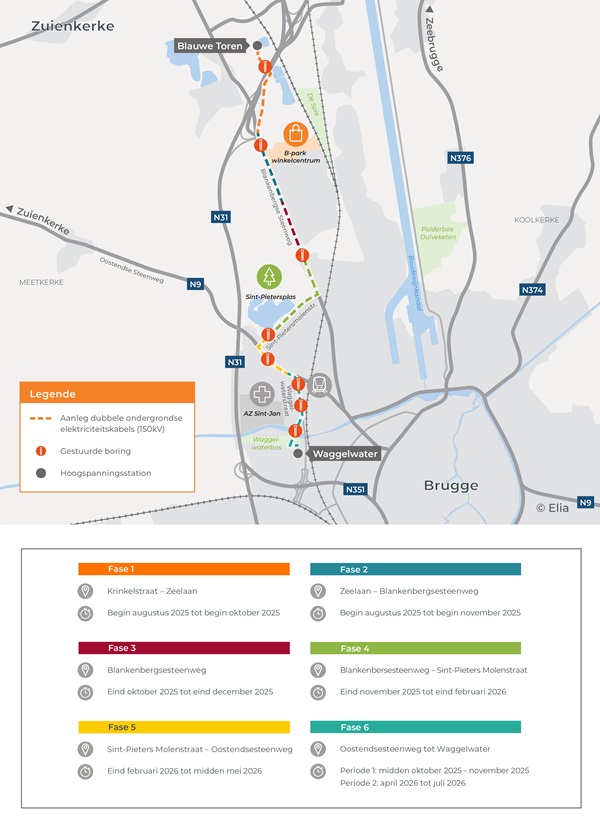Laying of underground high-voltage cable begins
On 4 August, we will start laying a new underground 150 kV cable between the Brugge Blauwe Toren and Waggelwater high-voltage substations. This cable will replace the existing 150 kV line, which will be upgraded at a later date. The works will be carried out in phases and will take a year to complete.
In the future, we will dismantle the existing overhead line between Brugge Blauwe Toren and Waggelwater with a view to building a new, stronger high-voltage line (380 kV) at the same location. However, a local 150 kV connection between Blauwe Toren and Waggelwater remains key to guaranteeing the security of the area's energy supply, which is why we will start laying an underground 150 kV cable between Blauwe Toren and Waggelwater on 4 August.
The cable will be laid under existing roads and will run from the Blauwe Toren high-voltage substation via Zeelaan, towards Blankenbergse Steenweg, Sint-Pietersmolenstraat and Oostendse Steenweg towards Waggelwaterstraat. The route, which spans a total of 6.2 kilometres, was developed in consultation with the city of Bruges, the relevant authorities and the Flemish Agency for Roads and Traffic (AWV). The works will last one year.
The complete overview of the route is provided below.
Minimising disruptionWe will do everything we can to minimise disruption to traffic during the laying of the cable, in consultation with the city authorities and the police, and are taking a number of additional measures to this end. As such, the underground cable will be laid per trench section, each of which spans one kilometre. We will start working on these trench sections one at a time to ensure that disruption is always limited in terms of time and space.
There will be a temporary change in local traffic rules during the works on the route. The contractor will provide the necessary signage on site to inform people of this change.
- Zeelaan and Krinkelstraat: through traffic will remain possible but site traffic and cars will use the same lane.
- Blankenbergse Steenweg: two-way traffic will still be possible for the most part (via the middle lane), while alternating traffic with traffic lights will be in place during the demolition of the central islands.
- Blankenbergse Steenweg - Kolvestraat: sign at the A11 exit: 'Major disruption at the Kolvestraat intersection - Follow the diversion for an alternative route to Monnikenwerve'. Diversion via Arthur Vierendeelweg -> Pathoekeweg -> Monnikenwerve (this is not a mandatory diversion but is recommended).
- Sint-Pietersmolenstraat: during work on this street, there will be one-way traffic from Blankenbergse Steenweg to Oostendse Steenweg; cars and cyclists must follow the diversion.
- Oostendse Steenweg: two-way traffic will be possible aside from at certain points during the demolition of the central islands.
- Waggelwaterstraat: two-way traffic will be possible at all times.
We will also carry out eight directional drilling operations along the entire route. Performing directional drilling avoids having to completely shut down waterways or busy roads. This will involve a directional drilling operation to cross 3 zones: the N31, the Zeelaan and the Krinkelstraat; the Zeelaan and the Blankenbergse Steenweg; and the Waggelwaterstraat, the Ghent-Ostend Canal and the Waggelwaterbos forest.
We also endeavour to take the usual steps to minimise disruption: the works will only be carried out during the day, residences and businesses will remain accessible while the works are in progress, local residents will be notified individually in the event of specific disruption or diversions, and there will not be any interruptions to the power supply during the works. Once the cable has been laid, we will restore the road to its original condition.



